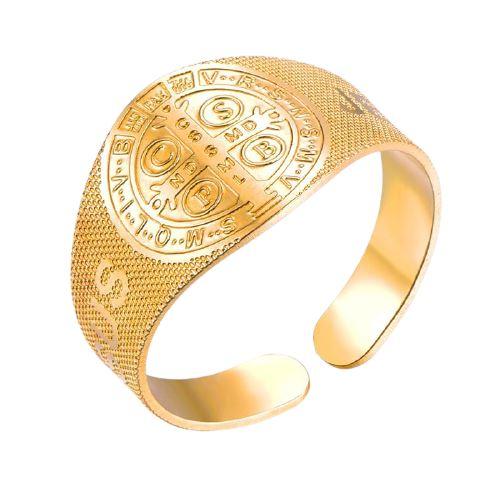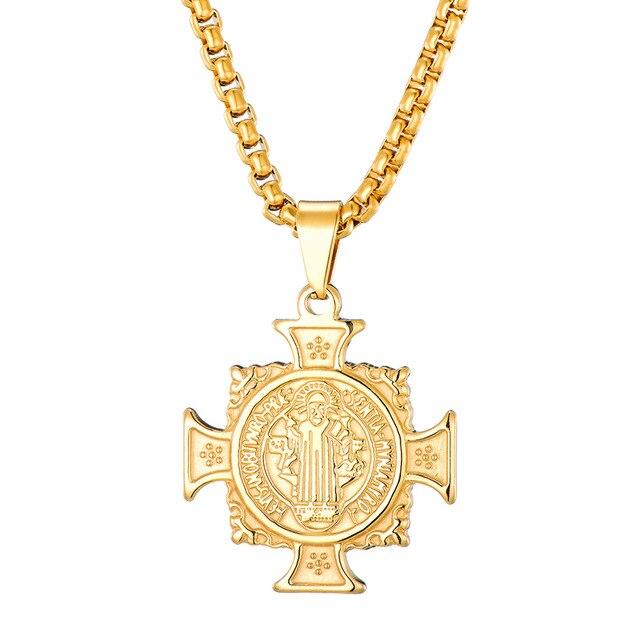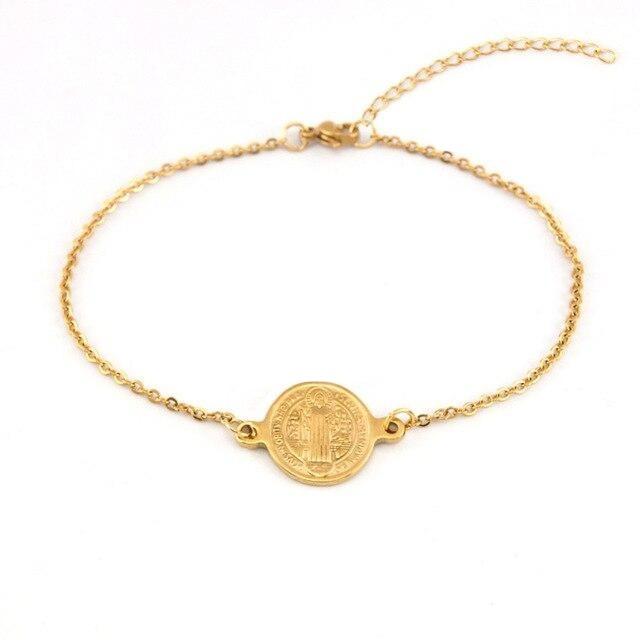Medal of Saint Benedict: Virtues, Powers and Meaning
The medal of Saint Benedict is one of the best-known religious symbols in the Christian world. Throughout its history, it has demonstrated that it has significant powers of protection or deterrence against evil.
These powers do not come from nowhere: this religious medal is adorned with inscriptions which each have a precise meaning... which we are going to discover together today!
So you want to learn more about this Christian jewel, since its history or its powers interest you? Discover through this article its origin, the particularity of its inscriptions, its benefits, and much more.
Contents :
What is the Saint Benedict medal?
The use of the Saint Benedict medal throughout history
The story of Saint Benedict and this religious medal
Symbolism of the Saint Benedict medal
What is the meaning of the Saint Benedict medal?
How to wear the Saint Benedict medal?

What is the Saint Benedict medal?
The medal of Saint Benedict is one of the most venerated religious objects. This is an engraved medal which occupies an important place in the Catholic religion. It is a sacramental object directly linked to the story of Saint Benedict.
This sacred jewel thus includes several Christian figures and inscriptions. It conveys to believers the value and miraculous powers of God. Since its appearance in the Middle Ages, it has often been used in exorcism or to fight demons. However, the powers of this miraculous medal do not prevent evil from working in our daily lives, but only protect us against its relentlessness.
Whether we take this ring, this medal or this bracelet : all carry the medal of Saint Benedict, and therefore his power of protection.
Given their capabilities, these objects are today considered religious jewelry of great importance. They are generally given as a baptism gift or birth gift. Typically, the necklace linked above will often be named a “ Saint Benedict baptism medal ”.
Origin of the Saint Benedict medal
Very old, the Saint Benedict medal appeared in the Middle Ages. At first, it had a shape identical to that of a cross. Its appearance today is linked to the story of Bruno of Eguisheim-Dagsbourg who was Pope Leo IX. When he was still a young Benedictine, he says in his story that this religious object would have saved him when he almost died after a snake bite. This future pope claimed that Saint Benedict should have touched him with a radiant cross to deliver his suffering. After his sacrament in 1049, he redesigned the cross in the form of a medal to engrave the image of Saint Benedict.
Approval of Pope Benedict XIV
The medal of Saint Benedict is a Catholic jewel which benefits from the apostolic blessing of Pope Benedict XIV (on whom here is a descriptive sheet). Following the request of Dom Bennon Lôbal, the abbot of the Sainte-Marguerite monastery in Prague, the pope published a pontifical brief in March 1742. This document invites the faithful to use this pendant.
The use of the Saint Benedict medal throughout history
The use of the Saint Benedict necklace pendant goes back a long way. In 1415, the monks of the Benedictine abbey of Metten discovered the initials of this miraculous medal in a very old manuscript. This document also reveals a representation of Saint Benedict between 480 and 547 who attacked the demon.
Since this discovery, this religious object has continued to prove its powers. Several stories reveal that he saved lives or helped certain people face particular situations. Its use would have made it possible to treat the toothache of a Jesuit in January 1849 and the leg of a sacristan in February 1861.
Around 1854, this medal would also have allowed an elderly woman under the influence of an evil spirit to be reconciled with God before dying. Around the first half of the 19th century, the force of evil would have terrorized the occupants of a room serving as a café and a billiards table. No religious practice could deliver the place until the use of the medals of Saint Benedict. In February 1859, the miraculous object was also said to have saved a child from a horse-drawn carriage when he was crossing Rue de Rivoli in Paris.
Today, the Saint Benoix medal is still one of the religious jewelry most used by believers to face certain difficult situations.

The story of Saint Benedict and this religious medal
Lived between 480 and 547, Saint Benedict is the founder of the Benedictine order. This is why Catholic and Orthodox believers consider it the origin of Western monasticism. He is therefore the father and inventor of the monastic way of life. Saint Benedict is then classified among the most important saints for the Catholic Church and even for Europe.
It should be noted that some large European cities were initially Benedictine monasteries. The name of the German city Munich and Monaco on the French Riviera is also synonymous with monk.
To wage his fight against evil and dispel temptations, Saint Benedict used the sign of the cross. According to the story, he has a strong devotion to this symbol. This is why he received many extraordinary faculties from God. Through the cross he could break a vase, stop a fire in the monastery, etc.
To learn more about him, here is a description of the life and work of this great Christian Saint.

Symbolism of the Saint Benedict medal
At first, this miraculous pendant looked like a cross. Today, the graphic image of this religious jewel represents a round pendant approximately 7.5 cm in diameter. There are also other larger models that measure 18.5 cm in diameter or smaller 2.5 cm in diameter. The medal is generally available in stainless material in stores specializing in the sale of religious articles.
Physically, this pendant necklace has two facets which each have several inscriptions and some religious images.
- On the obverse, it displays the image of Saint Benedict holding a cross in one hand and a book in the other. This figure is surrounded by a legend mentioning Sanctus Benedictus monachorum Patriarcha.
- On the reverse, we find the image of a cross called the cross of Saint Benedict. This is engraved with several series of letters serving as an anagram. The date of the first casting of the medal is inscribed under the feet of the effigy of the saint. There we find EX SM CASINO MDCCCLXXX which translates “Archabbey of Monte Cassino 1880.
The Saint Benedict medal is certainly heavy in symbolism... but it is far from being the only one! To discover others, take a look at this collection of Catholic medals which, all with their unique powers, will bring you closer to the virtues and moral values of the Church.
What is the meaning of the Saint Benedict medal?
Like all religious medals, each inscription and figure on the facets of this object contains a special meaning. The pendant thus conveys a precise message to believers and through secular culture.
Most notably, the Saint Benedict medal is covered in exorcisms. If you don't know what this term means, here is a definition according to the Catholic Church of France.
Meaning of the inscriptions on the side of the cross
On the obverse of the medal, it is possible to find the image of the cross of Saint Benedict. Several inscriptions are engraved all around and on this figure. These anagrams are supports to ward off evil and its actions.
The cross thus bears the letters CSSML which is the initial of “ Crux Sacra Sit Mihi Lux ”. This means “Let the Holy Cross be my light. There is also the anagram NDSMD (Non Draco Sit Mihi Dux) which means “Let the dragon not be my guide”. Between each branch of the cross, 4 characters form the acronym CSPB (Crux Sancti Patris Benedicti) which translates “Cross of the Holy Father Benedict”.
Around the cross, we also find the inscription VRSNSMV (Vade Retro Satana, Numquam Suade Mihi Vana which means "Get away Satan, never advise me of your vanities"). In addition, there is the acronym SMQLIVB (Sunt Mala Quae Libas, Ipse Venena Bibas). This means “the drinks you offer are evil, drink your poisons yourself”.
Finally, the medal displays on its top the word PAX which means Peace or the acronym IHS which translates Jesus Savior of men.
Meaning of the inscriptions on the side of the effigy of Saint Benedict
On the other side, this medal represents the image of Saint Benedict carrying a cross and the Holy Rule. It also displays the representation of the miracles performed by this religious character. On the left we find the poisoned cup with a snake inside and on the right a crow carrying away the poisoned bread.
Above two previous images, we notice the inscription Crux S. Patris Benedicti which means “Cross of the Holy Father Benedict”. On the outer edge of the medal, the effigy of the saint is surrounded by an inscription Eius In Obitu Nostro Praesentia Muniamur. This means “May we be strengthened by his presence when we die”.

How to wear the Saint Benedict medal?
To this day, there is no formal indication of how to wear the Saint Benedict medal. It is then possible to put it around the neck or hang it on a rosary. This second option is the most common among religious people.
For non-believers, this medal is generally worn as jewelry. Jewelers make necklaces and use different types of materials for the design. For the celebration of religious events, the Saint Benedict medal is a very original gift idea. The godfather and godmother can thus make a gift of a silver necklace with a silver pendant or a white gold pendant or a gold-plated pendant imitating this medal.
To benefit from the powers of this sacramental religious jewel, it must be blessed before wearing or using it. The simplest way to perform the ritual is to place the lucky medal in front of you on top of a white cloth and fix it in order to engrave its image in the mind. We must then say a prayer addressed to God, while requesting the goodwill of Saint Benedict. It is also possible to ask a priest to bless the medal.
More broadly, if you are interested in using religious objects as spiritual protection, take a look at this collection of lucky charms and Christian jewelry : you will definitely find something to strengthen your faith!

The miracles linked to the medal of Saint Benedict
Thanks to his unfailing devotion to the love and power of God, Saint Benedict is said to have received special gifts. This gave him the ability to perform certain miracles throughout his life.
The poisoned glass
When he was invited to succeed a recently deceased abbot, Saint Benedict is said to have sparked a wave of discontent among the monks of the monastery. The religious Brothers therefore decide to kill him by poisoning his wine. After St. Benedict made the sign of the cross, the glass containing the poisoned drink shattered.
Poisoned bread
Regarding the miracle of the poisoned bread, Saint Benedict discovered the poisoning through the illumination of the Holy Spirit. Following this, he asked a crow to take the bread to a place very far away.
The stone that moves
The miracle of the moving stone was manifested when St. Benedict prayed and blessed the block of rock that was blocking the construction of a monastery. After failing at all attempts, the monks in charge of the construction site actually sought help from Saint Benedict, thinking that evil was exerting its evil force on the stone.
What are the protective powers of the Saint Benedict medal?
The medal of Saint Benedict contains innumerable useful powers to keep intact or renew the bond with the Lord. This miraculous jewel has indeed revealed throughout its history powers of healing, protection and deliverance.
Healing power of the Saint Benedict medal
Given its history, the medal of Saint Benedict is capable of performing miracles and healing wounds and illnesses. The most notable event is the healing of a sexton in February 1861. The medal healed this young man's wounds in just a few hours.
Prayer support in the context of exorcism
Throughout history, religious medals like that of Saint Benedict have always been a powerful symbol to make the devil tremble. This is why they are often used during an exorcism session.
Tool for protection against demons' ambushes
Wearing the medal of Saint Benedict helps protect oneself against the traps of demons. This religious object can help you if you have to face a worrying situation. He is able to keep you away from dangers that may arise.
Source of spiritual grace
Blessed by the saints and by God through prayers, the Saint Benedict medal is often the ideal way to lead a person to obtain God's grace. In a way, it allows us to save the soul of a lost faithful or a loved one who refuses to reconnect with the Lord. The miracle that took place in a hospice in 1854 is irrefutable proof of the converting power of this medal.
Lucky charms featured in this article

Saint Benedict Medal Ring
See more
Medal of Saint Benedict
See more
Bracelet with the Medal of Saint Benedict
See more


